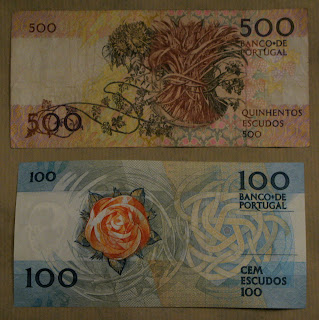Wednesday, February 29, 2012
Saturday, February 25, 2012
Wednesday, February 22, 2012
Monday, February 20, 2012
ALFÂNDEGA DO PORTO

Part of the customs house in Porto with its massive cast iron doors and slender temple of the winds columns. The beam is a real I-Beam made of riveted metal plates. This would predate Post-Modernism by more than a century - except here, the scale is right. Tracks on the floor enabled carts to go around with the goods to be inspected or securely stored.
Saturday, February 18, 2012
Monday, February 13, 2012
OLD MONEY

Whether you agree with the single currency or not, or believe in the Euro implosion based on mountains of debt and speculation, the moral conundrums of a transfer economy, etc etc there is no question the old money was incredibly richer (visually, alas) than the new. These were the last bills to be issued before the Euro came, in 1999.
Saturday, February 11, 2012
ROMANTIC GARDEN
Near Palacio do Freixo, in Porto, we can visit one of the first romantic gardens in the city - the Quinta de Villar d'Allen, from the early 19t century. Although it's still in private property, the current owner, third generation from João d'Allen, will kindly open its doors to all visitors who are interested not only in seeing one of the most exotic gardens in Porto but also their world class camellia grove and nursery. In the photos above we can see the main facade with the french garden in front and a view from the garden, showing a flaming urn designed by the italian architect Nicolau Nasoni.
Thursday, February 9, 2012
Wednesday, February 8, 2012
Monday, February 6, 2012
BARROCAS
As the weather triumphs over the limestone, the Cross triumphs over the Dice in the church of Barrocas, Aveiro. Maybe there is some other meaning to the number on the faces of the die. But who knows, and who cares - this is as glorious a window as can be.
Friday, February 3, 2012
TRAIN STATION CLOCK
Pinhão Train Station.
All of Portugal's train stations were, at a time, designed in the same style with the same materials, and few regional variations. Tiles were used profusely which depicted local scenes, monuments, landscapes. A Portuguese train station was easily identified as a building type.
We don't know if this wonderful clock was as ubiquitous as the painted tiles on the walls, but its design has both a modern dial and a beaux-arts body. This softness of style, both traditional and functionalist, is not unlike the mix which makes most old Portuguese stuff.
Subscribe to:
Posts (Atom)















